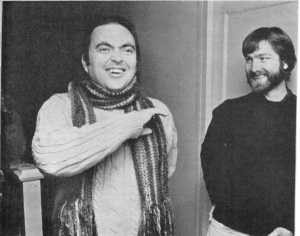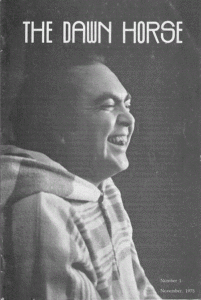Originally published in ‘The Dawn Horse’ magazine, Number 1, November, 1975.
My Life is Nothing
December 10, 1974

Bubba (Adi Da): Regardless of your sympathy with the Teaching and its argument of non-seeking, you are a seeker. You are karmically bound to that intention of seeking, which is founded in vital shock. There is no way to get around it. It is simply the case. No mere sympathy or philosophical acceptance of the Teaching as a communication amounts to the dissolution of your karmas. Your undoing is a very functional process. It must take place in functional terms. That is why you must do sadhana. Just reading the books is not sufficient. You must assume the specific sadhana of Understanding.
The concept of vital shock is central to Adi Da’s Teaching. It is the contraction in the vital center, the great region of the navel, the reaction to taking form at birth, which is the motive and ground of all suffering.
That sadhana does not exploit the search, even though you are a seeker. That sadhana frustrates the search in you, undermines the search in you, but you do not do that sadhana. You cannot do the sadhana of no-seeking. The Guru gives it to you. The Guru yields to you those conditions of sadhana that undermine the search in you, even though all the while you are involving yourself in your search.
The Guru finds the dramatization in you and he applies a condition to it. The conditions of money, food, and sex apply generally to everyone, but your dramatization occurs in a very characteristic and personal way. So the Guru must respond to the karmic elaboration that you represent. And he responds to you personally until his Community becomes sensitive to your dramatization.
There are more conditions than simply the black and white ones that we print in the student book. That is why we have interviewers who, by observing the individual active in the Community or in his responses to us by correspondence, can see how he dramatizes and thereby steps aside from real knowledge of this principal activity, this principal contraction, this vital shock. Therefore we must know where and when and how to apply conditions to that dramatization of his life in which he becomes unconscious, in which he always fails to understand.
“There must be the real undoing of this vital shock”
There must be the real undoing of this vital shock and all its ramifications, which arise like the circles that appear when you throw a stone into a pool. You know that fundamental vital shock, or reaction, is responsible for the whole realm of your individual life, all the patterns of your life, all the fundamental assumptions and all the superficial ones. Student sadhana is the frustration, in very specific and concrete terms, of your dramatized life. When that frustration of dramatization occurs, then self-observation occurs. Self-observation cannot occur otherwise.
We cannot then communicate a student sadhana that has six or seven points and that is it—do them and you become realized. The conditions for sadhana are only basic, simple, general. The conditions will not serve unless they are applied to the specific dramatization of one’s individual life. When that personal and unique dramatization is knowingly frustrated, then spontaneously, automatically, self-observation arises.
“Vital shock, the contraction that truly is Narcissus”
And wherever there is self-observation, truly there must also be penetrating insight. That penetrating insight at first is superficial, behavioral, psychological, but ultimately one abides in that principal reaction, vital shock, the contraction that truly is Narcissus.
When one abides in that reaction, stably, without resorting to behavioral changes and analysis and recalling back to how it all started in your case and your mother and your father and all the rest of the nonsense—when one rests in that contraction, knowing it to be without cause, without background, without reason, but still resting in it, then there is insight into contraction itself, knowledge of what is just prior to that reaction, and further, the process within which the reaction of vital shock is an event. When you become thus sympathetic to what is prior to vital shock, then that reaction itself becomes obsolete. When there is stable sympathy and realization of what is prior to that reaction, then there is true enquiry, then there is truly the fulfillment of the student stage of sadhana.
Thus the student stage of sadhana is no superficial affair. It is not just observing the conditions for a year, reading the books, studying the courses, and all the rest of student life. There is a real process that represents the student’s sadhana, and no one has ceased to be a student until the process I have described to you is stably realized. Otherwise the sadhana that is required of a disciple is absolutely impossible for you. It just cannot be done.
You must become sensitive in your own case to the areas of dramatization wherein you become absorbed, become consoled, become forgetful, become self- indulgent. You must comprehend what those areas of self-indulgence, of dramatization are, and on the basis of that understanding, not because of any motivation to be good, but on the basis of knowing what it is you are up to, you must discipline yourself of that dramatization.
“You might as well be taking drugs somewhere.”
Only when that discipline appears is the fundamental insight I describe possible. Apart from that, without that discipline, without that fundamental insight, what you may call sadhana is total bullshit. You can read books and have insights and become pure and holy and blissful and freak out with samadhis and ecstasies and kriyas and all the rest, and none of it will amount to anything. It amounts to nothing. You might as well be taking drugs somewhere. All the kinds of things that I do in this Ashram, all the kinds of changes I create, all the different kinds of theatre, are basically ways to shake up the superficial level of sadhana that people tend to settle for, ways to produce this real crisis, the revelation of the dramatizations that people are addicted to.
“Every single moment of life is a play upon that vital shock”
Every single moment of life is a play upon that vital shock. And every single moment of life in the usual man is this reaction, this theatre of Narcissus that is played upon this contraction at every moment. But you cannot become sensitive to the contraction of vital shock in the usual, ordinary round of your daily life until you see it as a powerful drama of fear in an ordinary moment, perhaps while walking down the street. Until you really see that every moment of your silly and superficial life is of exactly the same kind of profundity and horror as the most insanely psychotic moments that you can imagine or that you may have experienced, only then can you really do sadhana from moment to moment. Otherwise you are only doing sadhana in the great moments, which occur very rarely, and even then you find conventional ways of getting out of them.
Just so, news of death and calamities and disease and sorrowful changes produce a crisis in us, but it does not even really affect us, because we have conventional ways of dealing with these moments, conventional ways of getting freaky or of dramatizing the news to prevent our real understanding of them. It is not until we begin to know, through attention and real comprehension, the ordinary moment-to-moment, blase’, simplistic little asshole life that we are living that the real affair of student sadhana occurs.
More on “Vital Shock”
